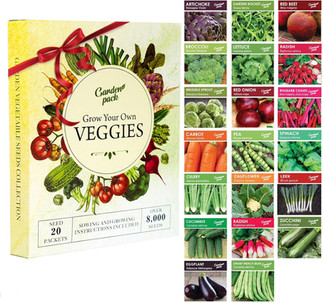Gardening in Yorkshire: Seasonal Planting Tips for November
- Andrew Limbert

- Nov 1
- 5 min read
As the chill of November settles over Yorkshire, your garden holds untapped potential. Forget the myth that winter means a full stop for your green spaces. With the right seasonal planting tips, you can transform your plot into a haven of colour and flavour. This month, we'll guide you through what to plant in your Yorkshire garden, ensuring it thrives even as the days grow shorter. From vibrant blooms to robust veggies, discover how to keep your garden lively and productive all season long.

(This post includes affiliate links. If you purchase a product using our link, we may earn a small commission at no extra cost to you — it helps keep the Poppleton Post kettle on!)
Before we dive into the specifics of November gardening in Yorkshire, it's crucial to understand the unique climate that shapes our horticultural practices. Yorkshire's weather patterns, soil types, and microclimates all play a significant role in determining what thrives in our gardens.
Unique Weather Patterns
Yorkshire's weather is as varied as its landscape. The county experiences a temperate climate, with cool summers and mild winters, but local conditions can vary widely.
In November, we typically see a mix of crisp, clear days and damp, overcast periods. Average temperatures hover around 5-10°C, with the possibility of early frosts. Rainfall is common, making water conservation less of a concern than in other regions.
The Pennines create a rain shadow effect, resulting in drier conditions in eastern parts of Yorkshire. This variation in rainfall affects plant choices and watering routines across the county.
Soil Types and Their Impact
Yorkshire boasts a diverse range of soil types, each with its own gardening challenges and opportunities.
In the Dales, you'll find thin, alkaline soils over limestone, perfect for alpine plants. The Vale of York offers rich, fertile loams ideal for vegetable growing. Coastal areas often have sandy soils that drain quickly but warm up early in spring.
Understanding your soil type is crucial for successful gardening. Conduct a simple pH test to determine if your soil is acidic, neutral, or alkaline. This information will guide your plant selection and any necessary soil amendments.
Microclimates in Your Garden
Even within your own Poppleton garden, you'll likely find various microclimates that can significantly impact plant growth.
South-facing walls create warm, sheltered spots perfect for tender plants. North-facing areas, conversely, are suited to shade-loving species. Low-lying areas may be prone to frost pockets, while elevated spots might be more exposed to wind.
Observe your garden throughout the day and season. Note where the sun falls, where water collects, and where the wind hits hardest. Use this knowledge to place plants where they'll thrive, creating a garden that works with, rather than against, nature.
Best Plants for Yorkshire

Now that we understand Yorkshire's climate, let's explore the plants that thrive in our November gardens. From autumn flowers to hardy vegetables and native species, there's plenty to keep your garden vibrant as winter approaches.
Autumn Flowers to Sow
November doesn't mean the end of floral beauty in your Yorkshire garden. There are several flowers you can sow now for late autumn and early spring colour.
Hardy annuals like cornflowers and calendulas (known as the english marigold) can be sown directly into the ground. They'll survive overwinter and provide early blooms next year. For instant colour, plant pre-grown winter pansies and violas in containers or borders.
Consider planting spring-flowering bulbs like daffodils, tulips, and crocuses. While they won't flower immediately, they'll establish roots over winter, ready to burst into life when spring arrives.
Don't forget about ornamental grasses and seedheads. Plants like miscanthus and sedum offer structural interest throughout winter and provide food for wildlife.
Hardy Vegetables for November
Believe it or not, November is a great time to sow certain vegetables in Yorkshire. These hardy crops can withstand our winter conditions and provide fresh produce in the colder months.
Broad beans and peas can be sown now for an early crop next year. They'll establish slowly over winter and take off in spring. Garlic is another excellent choice, benefiting from the cold to develop good-sized bulbs.
For quicker results, plant winter salad leaves like lamb's lettuce and mizuna in a cold frame or unheated greenhouse. These will provide fresh greens throughout winter.
Root vegetables like carrots and parsnips can still be harvested from earlier sowings, their flavour improved by frost.
Native Plants for Beginners
For those new to gardening in Yorkshire, native plants offer a foolproof way to create a thriving garden that supports local wildlife.
Hawthorn and holly are excellent choices for hedging, providing shelter for birds and small mammals. They're also visually appealing, with berries that add winter colour.
Foxgloves and primroses are beautiful native flowers that thrive in Yorkshire's climate. They're easy to grow and will self-seed, creating natural drifts over time.
For damp areas, consider native wetland plants like yellow flag iris or purple loosestrife. These not only look stunning but also help manage water in your garden.
Seasonal Planting Tips

With our plant selection sorted, let's focus on the practical aspects of November gardening in Yorkshire. From bed preparation to essential tasks and pest management, these tips will help ensure your garden thrives through the colder months.
Preparing Your Garden Beds
November is an ideal time to prepare your garden beds for the coming year. This preparation will give you a head start when spring arrives.
Start by clearing any remaining summer crops and weeds. Compost healthy plant material, but dispose of diseased plants to prevent issues next year. Once cleared, add a layer of organic matter like well-rotted manure or compost to improve soil structure and fertility.
If your soil is heavy clay, consider adding grit or sand to improve drainage. For sandy soils, extra organic matter will help retain moisture. Leave the surface rough to allow frost action to break down soil clumps over winter.
Finally, consider covering prepared beds with cardboard or black plastic. This will suppress weed growth and keep the soil dry, making it easier to work when you're ready to plant in spring.
Essential November Tasks
November in Yorkshire brings a unique set of gardening tasks. Focusing on these will set your garden up for success in the coming months.
Plant bare-root trees and shrubs. The dormant season is perfect for establishing these plants.
Protect tender plants from frost. Use fleece or bring them into a greenhouse if possible.
Clean and sharpen your tools. This often-overlooked task will make spring gardening much easier.
Rake leaves and make leaf mould. It's a free, nutrient-rich soil improver.
Don't forget to keep bird feeders topped up. Our feathered friends need extra support as natural food sources become scarce.

$50
Product Title
Product Details goes here with the simple product description and more information can be seen by clicking the see more button. Product Details goes here with the simple product description and more information can be seen by clicking the see more button

$50
Product Title
Product Details goes here with the simple product description and more information can be seen by clicking the see more button. Product Details goes here with the simple product description and more information can be seen by clicking the see more button.

$50
Product Title
Product Details goes here with the simple product description and more information can be seen by clicking the see more button. Product Details goes here with the simple product description and more information can be seen by clicking the see more button.
.png)





























Comments